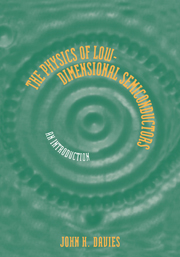Book contents
- Frontmatter
- Contents
- Preface
- Introduction
- 1 FOUNDATIONS
- 2 ELECTRONS AND PHONONS IN CRYSTALS
- 3 HETEROSTRUCTURES
- 4 QUANTUM WELLS AND LOW-DIMENSIONAL SYSTEMS
- 5 TUNNELLING TRANSPORT
- 6 ELECTRIC AND MAGNETIC FIELDS
- 7 APPROXIMATE METHODS
- 8 SCATTERING RATES: THE GOLDEN RULE
- 9 THE TWO-DIMENSIONAL ELECTRON GAS
- 10 OPTICAL PROPERTIES OF QUANTUM WELLS
- A1 TABLE OF PHYSICAL CONSTANTS
- A2 PROPERTIES OF IMPORTANT SEMICONDUCTORS
- A3 PROPERTIES OF GaAs–AlAs ALLOYS AT ROOM TEMPERATURE
- A4 HERMITE'S EQUATION: HARMONIC OSCILLATOR
- A5 AIRY FUNCTIONS: TRIANGULAR WELL
- A6 KRAMERS–KRONIG RELATIONS AND RESPONSE FUNCTIONS
- Bibliography
- Index
6 - ELECTRIC AND MAGNETIC FIELDS
Published online by Cambridge University Press: 05 June 2012
- Frontmatter
- Contents
- Preface
- Introduction
- 1 FOUNDATIONS
- 2 ELECTRONS AND PHONONS IN CRYSTALS
- 3 HETEROSTRUCTURES
- 4 QUANTUM WELLS AND LOW-DIMENSIONAL SYSTEMS
- 5 TUNNELLING TRANSPORT
- 6 ELECTRIC AND MAGNETIC FIELDS
- 7 APPROXIMATE METHODS
- 8 SCATTERING RATES: THE GOLDEN RULE
- 9 THE TWO-DIMENSIONAL ELECTRON GAS
- 10 OPTICAL PROPERTIES OF QUANTUM WELLS
- A1 TABLE OF PHYSICAL CONSTANTS
- A2 PROPERTIES OF IMPORTANT SEMICONDUCTORS
- A3 PROPERTIES OF GaAs–AlAs ALLOYS AT ROOM TEMPERATURE
- A4 HERMITE'S EQUATION: HARMONIC OSCILLATOR
- A5 AIRY FUNCTIONS: TRIANGULAR WELL
- A6 KRAMERS–KRONIG RELATIONS AND RESPONSE FUNCTIONS
- Bibliography
- Index
Summary
Electric and magnetic fields are among the most valuable probes of an electronic system. An obvious use of an electric field is to drive a current through a conductor; we studied conduction due to tunnelling in the previous chapter and will consider the opposite case of freely propagating electrons weakly scattered by impurities or phonons in later chapters. It is more surprising that useful information or practical applications can be obtained by applying an electric field to an insulator. An example of this is a change in optical absorption near a band edge caused by a strong electric field, the Franz–Keldysh effect, which we shall calculate in Section 6.2.1. This becomes even more useful when the electrons and holes are confined in a quantum well, and is used as an optoelectronic modulator.
A magnetic field has remarkable effects on a low-dimensional system. For example, the continuous density of states of a two-dimensional electron gas splits into a discrete set of δ-functions called Landau levels. This is reflected in the longitudinal conductivity as the Shubnikov–de Haas effect, giving a distinct signature of two-dimensional behaviour. The Hall effect is a widely used tool in semiconductors, and the combination with Landau levels in a two-dimensional electron gas gives the integer quantum Hall effect, where the Hall conductance is an exact multiple of e2/h.
- Type
- Chapter
- Information
- The Physics of Low-dimensional SemiconductorsAn Introduction, pp. 206 - 248Publisher: Cambridge University PressPrint publication year: 1997



